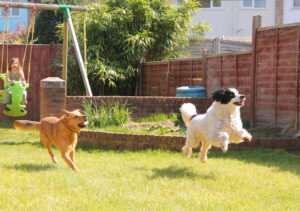
TPLO surgery is often the best course of action when dealing with a dog that has suffered a CCL rupture.
Dogs that have suffered a Cranial Cruciate Ligament (CCL) rupture—which is similar to a torn Anterior Cruciate Ligament (ACL) in humans—often need corrective surgery to mitigate the injury and slow the onset of arthritis. According to the American College of Veterinary Surgeons (ACVS), CCL rupture is one of the most common orthopedic injuries in dogs. There are non-surgical approaches, but surgery is the most commonly recommended treatment. Of the available surgical procedures, Tibial Plateau Leveling Osteotomy (TPLO) surgery is the most commonly performed.
What is TPLO Surgery?
TPLO surgery involves making a circular cut around the top of the tibia and rotating it until it achieves an approximately 90-degree orientation relative to the attachment of the quadriceps muscles. The joint is then stabilized by a bridging bone plate and screws—these aren’t needed once the injury has healed, but they are usually left in place to avoid a second surgery unless they become a problem.
TPLO surgery requires an osteotomy—cutting bone. The problem with this is that osteotomies can pose some risks and require secondary surgery if complications are noted. Thankfully, these instances are rare, especially in surgeries performed by board-certified veterinary surgeons.
Aftercare
Once your furry companion has undergone TPLO surgery, aftercare is crucial. Dogs are incredibly resilient, and your furry family member will want to be active long before the knee is ready. The acute pain from surgery is typically far less than chronic pain from injury. Most people are surprised how mobile dogs are after this procedure. Adhering to the prescribed activity level will be paramount to avoid further injury that requires another extensive surgery to correct.
Once cleared, physical rehabilitation is the best option for strengthening your dog’s joint post-surgery—activities such as passive range of motion, balance exercises, and controlled walks on a lead, among other activities. Talk to your veterinarian about what is safe for them to do and what should be avoided when you bring your pup home. This will give you a clear guide on how to approach your dog’s healing process through physical activity without straining the injured knee.
You should also discuss osteoarthritis management with your vet. While TPLO surgery can slow the development and offer an overall better prognosis, it can’t stop it entirely. Your veterinarian can help you develop a plan going forward that will keep your pup healthy and comfortable for as long as possible.
According to the ACVS, 85-90% of cases report significant improvement after surgery, so it’s a great option for many dogs that have experienced a CCL rupture.
Trust Maryland Veterinary Surgical Services With Your Companion’s Health
Your companion’s health is important, and the team at MVSS is ready to provide the best care possible for your furry family. We are dedicated to combining comprehensive exams and assessments with informative and honest discussions of your companion’s care. Once we have worked with you to decide on the best course of action for your dog, our professionals will use their surgical expertise to work towards the goal of giving your companion an active and pain-free life. We are proud to serve loyal companions in Catonsville and Baltimore. To learn more about our services, give us a call at 410-788-4088 or visit us online. For more information and tips for pet health, follow us on Facebook and Pinterest.
